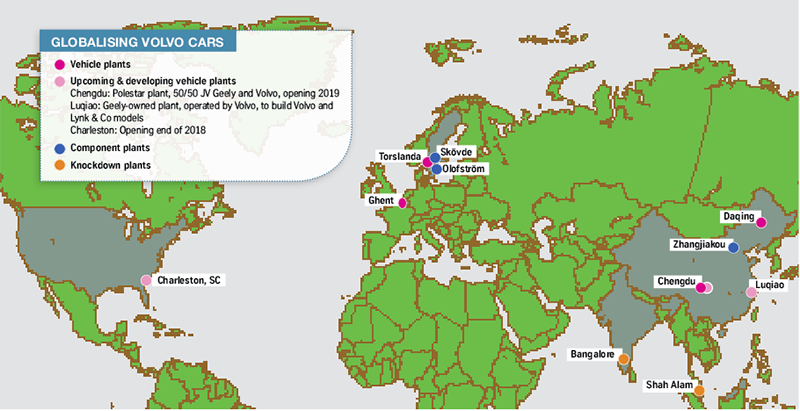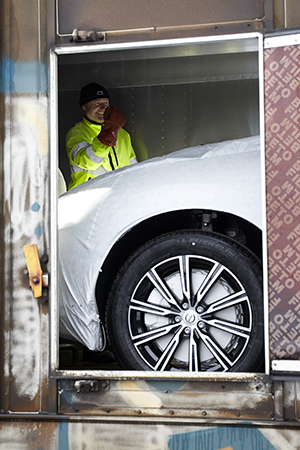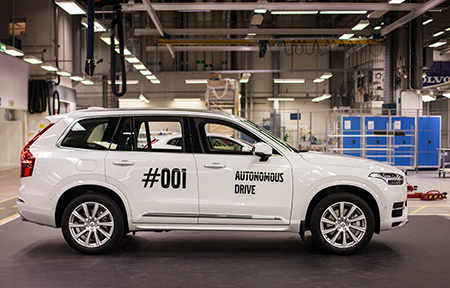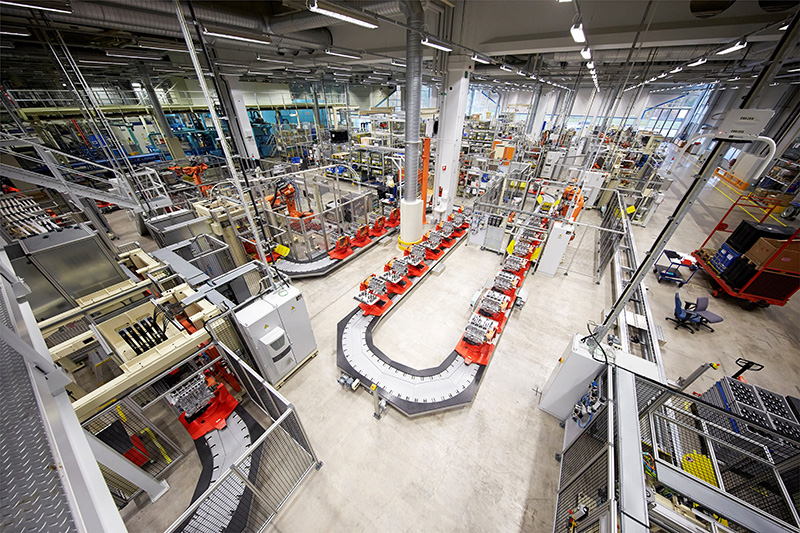 Since Geely Holdings acquired it from Ford Motor Company in 2010, Volvo Cars has been reinventing itself, from product development through to its industrial base and supply chain. Today, with a refreshed model line-up and amidst several new launches, sales have grown to record levels, with further expansion still to come.
Since Geely Holdings acquired it from Ford Motor Company in 2010, Volvo Cars has been reinventing itself, from product development through to its industrial base and supply chain. Today, with a refreshed model line-up and amidst several new launches, sales have grown to record levels, with further expansion still to come.
European output has grown strongly, with production at the Swedish carmaker’s plant in Torslanda, at its headquarters near Gothenburg, running on three shifts for nearly three years. Production of the new XC40 small SUV began in November last year at its factory in Ghent, Belgium, which will also produce the new V60.
[related_topics align=”right” border=”yes”]In the past five years, Volvo, together with Geely, has built an entirely new production network in China, which now includes three assembly plants, a powertrain facility and a new regional headquarters and R&D centre in Shanghai. Chinese assembly has fed strong domestic growth and provided a growing export base for Volvo, with its plant in Daqing, in the north-east, now the global export hub for the S90 sedan, shipping to locations including the US, Europe and Japan.
The carmaker is expanding further. Last year, it opened a knockdown-kit assembly plant in Bangalore, India. And by the end of this year, it will open its first US factory, with a $1.1 billion investment in Charleston, South Carolina, which will become the global production base for the new S60 sedan and will add the XC90 full-size SUV by 2021, when production capacity reaches 150,000 units.
Geely’s investment and partnerships with Volvo, meanwhile, are triggering expansion across brands and regions. Volvo has investment and shared development in Geely start-ups like Lynk & Co and Polestar. Meanwhile, Geely’s stake in Malaysian carmaker Proton may lead to further production and distribution of Volvo models in South-East Asia, for example.
Technology is set to change Volvo’s supply chain further. The OEM plans to electrify its entire model line-up in hybrids or battery electric vehicles. Zenuity, meanwhile, a Volvo joint venture with Swedish tier supplier Autoliv, is among a number of initiatives at the carmaker to speed the development of autonomous driving technology.
Setting a new path for logisticsAmid all this evolution, Volvo has also changed its logistics organisation significantly. Compared with its previous outsourcing of logistics management, Volvo now has tight operational control across the supply chain, including future model and industrial planning, network engineering and packaging. It has also implemented a fully integrated transport management system (TMS).

Michel Torreborre, vice-president of supply chain management, has led logistics over the past three years, overseeing changes that have included further integration of functions, from plant logistics to customs. “We are talking about substantial savings and improvements across cost, lead times, tied-up capital and quality,” he says.
Having a more integrated team has meant that Volvo’s logistics could better support new projects and innovations. The carmaker made history last year when it started using the China-Europe Express railway for several block train services per week to export the S90 from Daqing to Zeebrugge, Belgium, which have resulted in much shorter delivery times than ocean transport.
Logistics is also closely supporting Volvo’s expansion. By combining freight more efficiently, the carmaker can better manage vehicle launches despite a growing driver and truck shortage in Europe and in China. In the US, Torreborre’s team has helped to design the new plant and infrastructure to ensure the most efficient flow of material and vehicles, including plans to use rail significantly.
Logistical expertise will become even more important, not only as Volvo manages new supply and plant locations, but also in producing and handling electric vehicles and batteries.
Torreborre’s boss, Javier Varela, senior vice-president for manufacturing and logistics and a member of the executive board, who joined Volvo last year after a career with Toyota and Groupe PSA, wants to implement more lean manufacturing and logistics principles. According to Torreborre, Volvo now has the right organisation and team in place to do so.
Q&A with Michel Torreborre: Taking control of the supply chain
Looking across your operations, what would you say is causing you headaches right now?What is crucial right now for the European region is that we are launching a new vehicle from Ghent and so we need to secure enough truck capacity inbound and outbound to support growth. However, there is a shortage of truck capacity and drivers. Legislation is also getting tight in Europe in this regard. In Belgium, for example, we have had cases where truck drivers couldn’t take their rest period in truck cabs, only in rest areas – of which few are available.
If you look to China, it is similar, as the government is implementing new regulations for truck sizes and loading, all of which is necessary but is also reducing capacity.
 Outbound visibility does not have to extend to knowing where every vehicle is at all times, but vessel boarding and arrival confirmations can improve the overall picture
Outbound visibility does not have to extend to knowing where every vehicle is at all times, but vessel boarding and arrival confirmations can improve the overall pictureCan you mitigate these issues in any way other than reserving extra service capacity?A lot has to do with route and return planning, since many trucks run empty. I think carriers have to find other business models to use this free capacity, whether through better planning or technology.
Has your in-house team’s focus on network engineering and optimisation helped to improve efficiency and utilisation?Certainly. Higher volume helps, but we also now have the competence in-house to engineer flows continually, including full truckloads, less-than-truckloads and milkruns. That is part of our daily business. In the past, when our provider did that, it gained all the benefits and now we have them.
You have implemented a global TMS, but what is next in terms of improving your logistics IT systems?There is room to improve real-time management and we have plans for inbound and outbound. For example, taking the idea of the andon cord in a plant – in which workers pull a cord to signal a problem – we want andon boards for transport, where we can see any problems early as they arise and have time to react.
What will be the key for Volvo in capturing that visibility? Is it GPS and telematics in trucks or vehicles? Sensors or RFID?It could be a number of things and we will explore them. However, we are not in favour of RFID for cars or goods as it requires fixed gates and has limited flexibility.
For outbound, I don’t think we need to see where every car is all of the time, but rather we need to know that it boarded a vessel or reached a point of rest. When you combine that with visibility of the entire global vehicle pipeline, you get a good picture of the distribution chain.
Are you using data analytics tools to explore network optimisation and improve logistics operations?We do this on two levels. We have optimisation potential within our TMS, which we do frequently or even daily based on volume, supplier locations, etc.
We also carry out strategic network planning, which is more like looking into the future. We do this through a combination of what we have in our system plus forecasts to see how the world is changing and how we can prepare ourselves, for example, in terms of changes in the supplier base.
Is Volvo now running its own returnable packaging and container management?Yes, we fully insourced this about two years ago. We own the equipment and we do the planning, dispatch and returns for standard, returnable and one-way packaging, which is run as a sub-part of our TMS. We already have full responsibility in Europe and we will launch this way in the US. Asia-Pacific is currently in a transition phase.
What have been the benefits in taking container management in-house?We now have full control over how much packaging we need and how much we buy, as well as over lead times and transparency, with fewer missing containers.
What has been most challenging about container management?The issues are mainly around visibility and traceability. We also have one-way packaging in several cases, especially on cross-shipping between regions. For example, we typically use wooden pallets [for international shipments] but we are looking to change over to plastic.
Do you use or plan to use any returnable packaging for international freight?We are looking at different models for international packaging, including whether we should own or rent. We are still in the study phase, but if we did own our international packaging, we would have to find a way to keep the loop closed [between our plants and suppliers], otherwise packaging would just disappear.
One Belt, One Road, one customer
Last year, Volvo started to ship S90s from Daqing to Europe via rail. How reliable is the service proving in terms of timings, damage and visibility?We still need to see how everything runs this winter to experience all the seasons, but everything so far has been positive. We implemented the train service at a record tempo, in around six months for everything. We did a lot of testing – including of route quality, of the racks, of loading and unloading – and so far, the quality is very good.
Does the train run on time?The main issue is that we are not hitting our projected lead times, mainly because of works along the route within Europe and further east, which has impacted our original calculations. However, the difference in lead time has been a variation of 10-20% over roughly three weeks that we anticipated, so it is not large in comparison to shipping by vessel. We are also confident that once those works are done, the lead times will meet the original target.
Are you running return services back to China?We ran a trial of return vehicles but this is not yet a regular service.
Would you consider letting other OEMs use the return service?We have a block train for Volvo and our intention is to stay with that, because if you involve other companies you will have issues over timing and it could impact the visibility and timing, so there are no plans to start sharing.
[mpu_ad]Is it possible to use the return leg of the service to ship parts and materials?We have done pilots with freight to support the operation. A container’s advantage is that you can put anything you want in it, so loading freight is one of the possibilities, but it is still in the study phase and nothing has been decided.
Have you found the right racking system, or are you still considering options?The system we are using is our own. It is standardised and fits three vehicles and can also hold different model types.
Have you looked at additional stops with the train, whether in western China or elsewhere along the route?We are looking to develop round-trip journeys to the distribution yards in Chengdu, for example, which could be an interesting link. But that is all still in the concept phase.
Do you envision further substituting ro-ro or container shipping between Europe and China in a significant way?No, I don’t think you can compare ocean and rail. The train is 41 containers, with three vehicles each, while a ro-ro vessel or container ship is, of course, several thousand. The rail is just an alternative for particular cargo flows.
 American Volvo
American Volvo
With the Charleston plant set to launch next year, have you already established a supply chain and logistics strategy?The initial idea was to copy and paste our structure and processes from Europe, but we also took full advantage of what we have learned from China. We have designed the plant to be lean from the beginning, and it is highly efficient for logistics. Now we need to ensure that we also run it in a lean, efficient way.
 Geely owns the London Electric Vehicle Company
Geely owns the London Electric Vehicle CompanyUnder Geely, Volvo Cars is increasingly part of a wider group with shared engineering and even some manufacturing. Volvo and Geely jointly developed its compact modular architecture (CMA) platform, upon which Volvo’s 40 series models are now built, as well as products from Geely’s start-up brand, Lynk & Co.
As well as having a joint venture with Geely for technology development and a minority stake in Lynk, Volvo is operating a Geely-owned plant in Luqiao, in south-east China, which will build CMA-based vehicles.
Volvo Cars, meanwhile, has formed a 50:50 joint venture with Geely to launch Polestar as a standalone brand geared towards high-performance electric vehicles. It will build a new plant in Chengdu, where both Volvo and Geely have existing plants.
Geely’s wider automotive investments raise further potential for sharing resources and production. For example, it owns 49.9% of Malaysian carmaker Proton, and has suggested the company could build Geely and Volvo models in South-East Asia. Geely also owns the London Electric Vehicle Company – maker of London taxis – and 51% of British sports car producer, Lotus.
Despite these connections, Volvo remains separate from these brands in everything from design and strategy to sales. For logistics management, Torreborre emphasises that Volvo’s teams remain completely separate from Geely, Lynk & Co and Polestar.
“However, there is room to support each other and even combine certain things, whether in assigning staff, sharing know-how or eventually even freight,” he says. “We are totally split in terms of organisation, but if you take the case of Polestar, we will support it with process knowledge to help them launch, including customs, transport and packaging. We will then look for eventual synergies.”
Can you tell us about the logistical advantages Volvo has designed?At our existing plants, it is hard to turn fixed infrastructure into something lean. For the US, we have designed the docking gates, the material flow through the plant, the yards, all in the most effective way. For vehicles, we will have a vehicle processing centre directly on site.
We have also built a rail connection into the plant for goods and finished vehicles, by which we plan to ship the majority of vehicles. We have rail only partially in Sweden, but it is not ideal for us. In Ghent, we have limited rail for freight, and none at all for vehicles. None of our Chinese plants have direct rail access.
The plant was chosen in part because of its strategic location near the port of Charleston. How will containers between the port and plant be managed?The majority of containers will stay at the port and we will call them when we need them. From there they will move the 40km distance by truck, operating as a ‘warehouse on wheels’ with a daily transport flow.
What are the big logistics challenges in launching the plant?Anything you do that is so new is going to be a risk or opportunity, including getting to know new suppliers and providers. But for logistics, one of our biggest questions is around long-distance, just-in-sequence supply, especially from Mexico, where some of our suppliers are located.
While in Europe we have plenty of experience shipping parts long-distance, we lack experience of the distances in North America, and what we will face with intermodal changes, and especially for the border crossing between the US and Mexico.
We will really be running a ‘warehouse on wheels’ to the maximum extent in keeping inventory in the plant to a minimum, and we need to better understand all the implications around the border. The area is brand new for us – but that is also part of the opportunity.
Electric visions
 Developments in the way vehicles are owned, powered and driven mean that logistics at Volvo, as elsewhere, will have to be adapted
Developments in the way vehicles are owned, powered and driven mean that logistics at Volvo, as elsewhere, will have to be adaptedVolvo will build its first electric vehicle in China, and have batteries in all vehicles by 2019. Are you already looking at the logistics implications, particularly for batteries?There are challenges with moving batteries due to weight and legislation. We are continuously looking at options to improve and meet our electrification goals.
Volvo is also exploring new ownership and service models, such as subscription models, more online sales and car sharing. Do you foresee implications for logistics?Such services might have impacts, especially for the aftermarket, but could also change elements of outbound logistics in terms of locations or physical operations. But I don’t see any problems and we will just adapt.
You have led Volvo’s logistics through a period of great change in the past three years. What is your vision now?
I learn a lot daily from my boss, Javier Varela, especially in terms of lean manufacturing processes. Our big ambition is to become best-in-class in both logistics and manufacturing, which will help improve things like lead time and tied-up capital.
The second major thing is to support the electrification project and all the challenges that come with it.
 Torrebore has merged Volvo’s transport and MP&L organisations, and realigned logistics with manufacturing at several levels
Torrebore has merged Volvo’s transport and MP&L organisations, and realigned logistics with manufacturing at several levelsVolvo Cars’ logistics organisation has been changing and growing for the last six years. From a small team with minimal operational responsibilities and fragmented oversight of the supply chain, today it numbers nearly 600 white-collar staff globally, managing strategy and execution.
As of January 1st this year, it is also globally integrated, with central responsibility not only for common processes but also operations under Michel Torreborre for Europe, Middle East and Africa; Asia-Pacific; and the Americas. Prior to that, Torreborre had full responsibility for Europe but led only on common processes and governance elsewhere, with regional logistics steered by national sales companies.
At the beginning of this year, the department was also renamed from Logistics to Supply Chain Management to signal its global scope and maturity. The name signals a holistic, global focus beyond inbound and outbound transport, comments Torreborre.
To fully understand how far the supply chain department has come, you have to go back two decades, to before Ford bought Volvo Cars, when the carmaker was part of Volvo AB, the commercial vehicle and trucking group. As a combined company, logistics for commercial and passenger vehicles was combined under Volvo Logistics (today called Volvo Group Logistics Services), a group-owned provider.
When Ford bought Volvo Cars in 1999, rather than fully integrating it into the Ford of Europe material planning and logistics (MP&L) organisation, it contracted Volvo Logistics to manage logistics, including inbound transport, returnable packaging, vehicle logistics and a number of operations such as plant yards. The Swedish carmaker therefore had only a small team of logistics managers for oversight of the contract, as well as separate MP&L teams at its plants to manage material and onsite logistics.
After Geely bought Volvo in 2010, the carmaker soon set about analysing the situation again and several issues became apparent. Over time, Volvo Cars and Volvo AB had grown further apart. Although they still share a brand and plant locations in both Gothenburg and Ghent, that divergence has become greater, including fewer shared suppliers as well as locations as Volvo Cars pushes further into China. (Geely’s recent increase in its stake in AB Volvo to 8% has raised suggestions of a possible re-merger, although that remains highly speculative at this point.)
There were also issues around control and visibility of costs, as Volvo paid for logistics management as a service. When the logistics provider found benefits in the network, they went to the provider, not to Volvo, says Torreborre.
The insourcing of logistics was done as Volvo implemented a global transport management system, first in 2012 for outbound logistics, the next year for inbound in Europe, and thereafter in China. David Pansinger led this change as vice-president of inbound and outbound logistics until 2014, when he took over Volvo’s supplier quality and logistics group in Asia-Pacific, after which Torreborre assumed the logistics role.
Up to that point, Torreborre had been leading Volvo’s central MP&L organisation, which led in-plant logistics but was still separate from inbound and outbound logistics. As much of his career at Volvo since 1987 has been in plant logistics, supplier quality and vehicle launch roles, he understands the interaction between transport, inventory and manufacturing. One of his first actions in taking over inbound and outbound was to merge the organisation for transport with that of MP&L.
That was one of a number of significant changes over the past three years to create the current shape of Volvo’s logistics department, including a realignment of logistics together with manufacturing at the top level, as well as developing several different departments and sub-departments within logistics.
These include:• Core and car programme: responsible for project management across future car programmes, including scenario planning for inbound supply, material flow, packaging and vehicle logistics;• Industrialisation: works with individual plants to engineer logistics processes, layouts, packaging and materials handling equipment;• Industrial planning: a newly added department tasked with industrial and operational planning from a global perspective;• IT: develops and manages logistics IT and systems covering global logistics operations;• Inbound logistics and outbound logistics: manages providers and transport operations, with sub-departments including returnable packaging and yard management;• Customs: has full oversight of customs and duties; in Europe alone, this team has grown from six to 31 people.
While growth and development will influence Volvo’s logistics, Torreborre does not foresee further immediate changes to the organisation.
“Each time that you reorganise, you get new managers and move people around, which is correct and fantastic, but it also requires new job content, training and transition,” he says. “The focus for 2018 is on stabilisation.”
Topics
- Asia
- Autoliv
- Belgium
- China
- Electric Vehicles
- Europe
- features
- Finished Vehicle Logistics
- Geely
- Geely
- Inbound Logistics
- Inventory management
- London Electric Vehicle Company
- Lotus
- Lotus
- Lynk & Co
- Mexico
- North America
- Packaging
- Plant Logistics
- Polestar
- Policy and regulation
- Proton
- Rail
- Start-ups
- Sweden
- Telematics
- Track-and-trace
- United States Of America
- UPS
- Volvo
- Volvo Cars
- Volvo Cars
- Volvo Group
- Zenuity

























![Global[1]](https://d3n5uof8vony13.cloudfront.net/Pictures/web/a/d/s/global1_726550.svgz)













